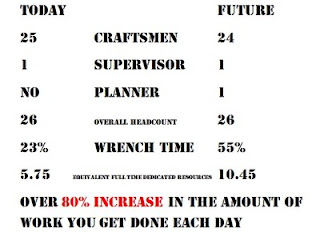Of all the sites I have been in all over the world, I have never met a maintenance manager who said to me “You know Shon I just have too many people.” In fact most ask me how they should go about bringing more into their fiefdom. It usually sounds a bit like this: “I need to hire planners, supervisors and a few more crafts in order to improve my reliability. If I could get support for more I could make this happen.”
Interestingly, the data tells me something entirely different. The average facility in our database is spending forty percent too much on maintenance. A portion somewhere between forty and sixty percent, depending on the industry, of that overage is labor. They are maintaining a wrench time, craft time doing value added work, of twenty three percent against a best practice of sixty-five percent. Think about that number a second, if you have twenty five craftsmen at twenty three percent wrench time that yields five point seven five FTEs (Dedicated fully utilized resource). On the flip side if you take one of those craftsmen and provide him the tools and training required to be a quality planner and scheduler then you can improve your wrench time to a very sustainable fifty-five percent. Now even with one person out of the craft ranks you can yield ten point four five FTEs without an overall head count increase. That is a eighty-one percent productivity increase… Image what that would do to your work backlog…and this is only one step to attaching high maintenance cost and unreliability. We could also talk about preventive maintenance optimization as well as others steps to provide additional gains. I'm a visual guy so here is another look at the math.

Now we know that it takes time to make the transition to the higher level of performance and that not every site is truly overstaffed but if you don’t think long and hard about wrench time productivity before you think about increasing your staff you could be doing both you, your company, and the person you hire a disservice. If you trust the benefits of planning and scheduling, the capability of your staff and you take the time to build a plan to get there you can do actually do more with less.





